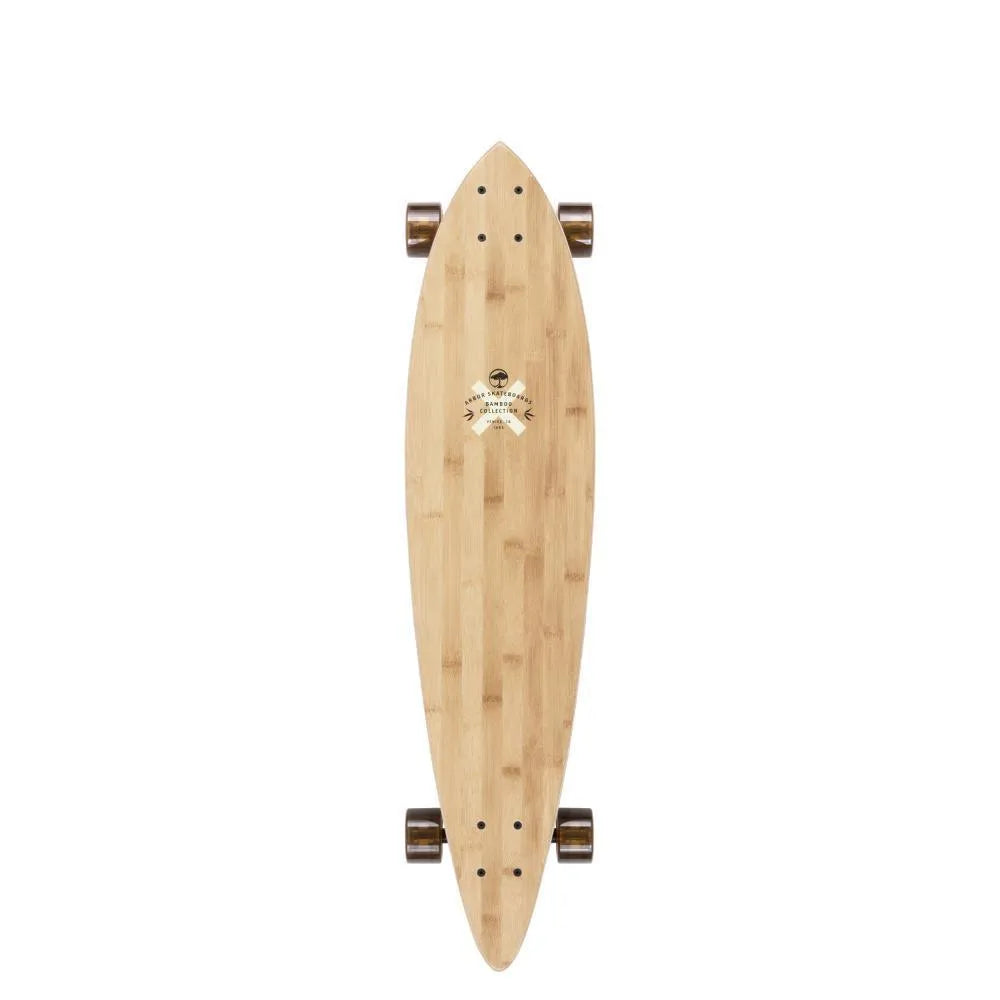Arbor 37" Cruiser Complete Bamboo Fish El Rose Skateboard
Arbor 37" Cruiser Complete Bamboo Fish El Rose Skateboard
En existencias
No se pudo cargar la disponibilidad de retiro
Arbor 37" Cruiser Complete Bamboo Fish El Rose Skateboard
- 7 Ply Canadian Hardrock Maple with a Carbonized Bamboo Finish Ply
- Wood material comes from sustainable sources of supply
- Wood by-product is reclaimed for use in other products
- Paris Reverse 50° 150mm
- Arbor Easyrider Series - Mosh
- Perfect mix between quick acceleration and roll speed
- Good for cruising and carving on all size boards
- Size: 65mm // Durometer: 78A
- Contact Patch: 36.0mm // Offset: 0.0mm
- Momentum Core: Dampens bumpy rides
- Venice Formula: Soft and grippy
- ABEC 5 Bearings with Spacers
- 1/8" Paris Risers
- Recycled Glass Re-Grit
Check out our full range of skateboards here
The humble cruiser skateboard
The cruiser skateboard has a unique place in skateboarding history. It blends function, style, and convenience. Unlike traditional a skateboard, cruisers are made for smooth rides and easy transport. Their roots go back to the early days of skateboarding in the 1950s and 60s. Back then, surfers in California wanted to "surf the streets." They used wooden boards with roller-skate wheels. This led to the first wave of skateboard innovation.
As skateboarding grew in popularity, so did the need for different styles of boards. Street skaters preferred smaller decks for tricks. Vert riders needed wider boards for ramps. But cruisers evolved to meet a different need. They were not built for tricks or big air. Instead, they focused on comfort and mobility. By the 1970s, brands like Bahne and Logan Earth Ski were making cruisers with polyurethane wheels. These wheels made rides smoother and safer. The cruiser skateboard found its niche.
In the 1980s and 90s, skateboarding focused more on tricks and competitions. Street skating became the norm. Cruisers faded into the background but never disappeared. They stayed popular with commuters and casual riders. In the 2000s, cruisers made a big comeback. Riders wanted boards that could handle sidewalks, cracks, and bumps. Skate companies began to release cruiser-specific models. These were stylish, functional, and ideal for city travel.
Cruiser decks come in many shapes and sizes. Most are between 7 and 10 inches wide. Lengths can range from 26 to 36 inches. The deck is often shaped with a kicktail, allowing quick turns and stopping. Some cruiser decks are flat, while others have slight concaves for grip and control. Materials also vary. Maple wood is common, but bamboo and plastic are also used. Penny boards, for example, are small plastic cruisers. They are lightweight and easy to carry.
Deck shape affects performance. Wider decks provide more stability but weigh more. Narrow decks are nimble but less forgiving. Some cruisers are shaped like mini longboards. Others resemble old-school skateboards with pointed noses and big tails. The choice depends on riding style and terrain. City riders might choose short, narrow decks. Beach cruisers may prefer longer boards with softer wheels.
Trucks on cruiser skateboards also differ from those on trick boards. Cruiser trucks are usually wider and sit higher. This allows for bigger wheels and smoother rides. Traditional kingpin trucks are most common. However, reverse kingpin trucks are used for better turning. Reverse kingpin trucks give more lean and carving ability. They are similar to longboard trucks but mounted to cruiser decks.
The truck width should match the deck width. A common setup is 150mm trucks on an 8.5-inch deck. Bushings also matter. Softer bushings allow easier turning and carving. Harder bushings give more stability at speed. Many cruiser riders prefer loose trucks. This helps with sharp turns and weaving through crowds.
Wheel choice is crucial for cruiser performance. Most cruiser wheels are large and soft. Sizes range from 60mm to 75mm. Durometer ratings are usually 78A to 85A. This makes them ideal for rough pavement. Larger wheels roll over cracks and pebbles with ease. Smaller wheels may be lighter, but they get stuck more easily.
Bearings are another key component. Good bearings make the ride smoother and faster. ABEC ratings are one guide, but not the only one. Many brands offer cruiser-specific bearings. These often have better seals to block dust and dirt. High-quality bearings reduce push effort and increase glide.
In summary, the cruiser skateboard has evolved with urban life. It serves those who value flow, style, and ease of use. With many deck shapes, truck types, and wheel options, riders can customize their cruisers. Whether you're commuting to work or exploring your city, a cruiser board makes the journey enjoyable.
Share






FAQs
Got a question? We are here to answer








